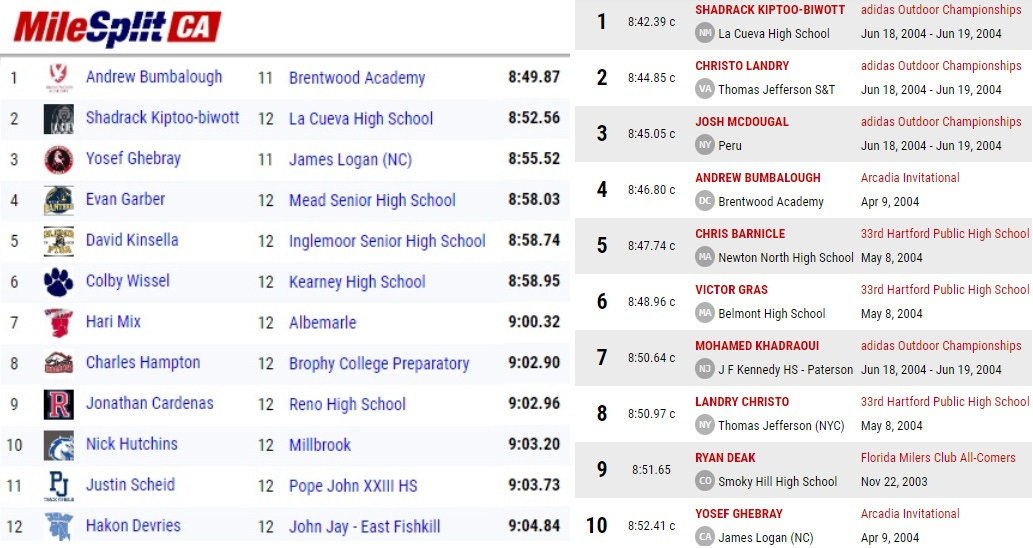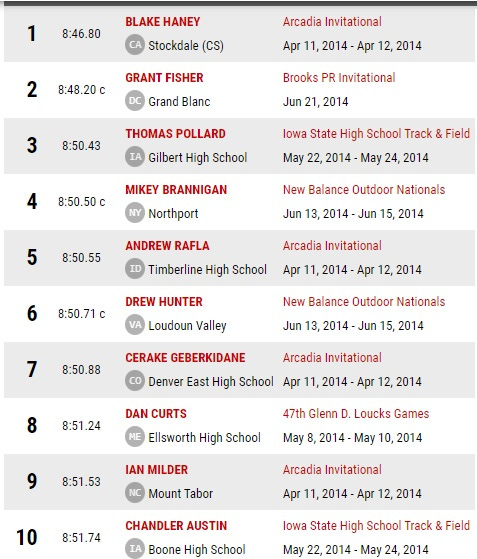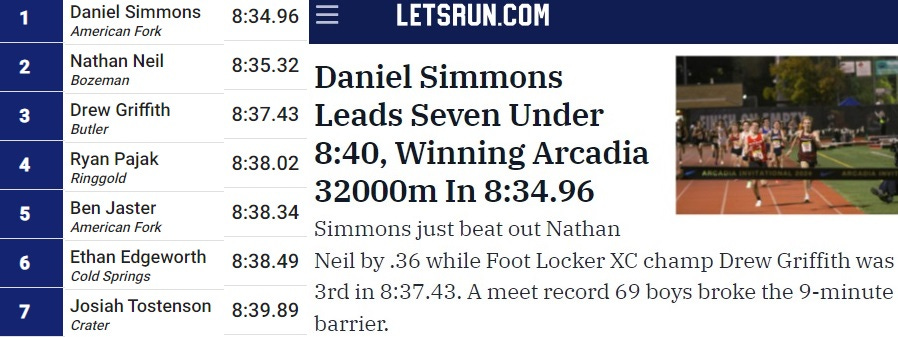High-school runners are obviously doping in significant numbers
Even assigning these kids a one-second-per lap penalty in the distance races to account for the advent of superspikes doesn't come close to explaining the glut of outrageous performances
The Arcadia Invitational, a high-school meet held in early April just east of Los Angeles, has been producing very fast times in the boys’ 3,200-meter run since the 1980s despite being held at least a month and a half before most U.S. state-championship meets and over two months before the unfurling of the U.S. national championship meets that were introduced in the early 1990s.
In the 2004 outdoor season, a total of six U.S. boys broke 9:00 for 3,200 meters, with Ryan Deak the fastest among them at 8:51.65. But that spring, the Arcadia Invitational featured two-mile races instead of 3,200-meter races. (Two miles is about 3,218.7 meters, adding just over three seconds to the 3,200-meter times of elite boys.) If converted Arcadia times are included on the final 2004 outdoor 3,200-meter performance list (indicated by “c” in the list below), then 25 boys went under 9:00 that spring, including nine who did do at Arcadia.
Ten years later, when the Arcadia Invite had resumed its tradition of offering 3,200-meter races, 20 boys broke 9:00 at Arcadia alone, including 19 in the invitational heat. This was rated by Milesplit as a remarkable feat:
That spring, a total of 41 boys nationwide broke nine minutes for 3,200 meters, with Arcadia winner Blake Haney’s 8:46.80 leading the U.S. list. If converted two-mile times are included on the final 2014 list, then 45 boys recorded sub-nine-minute 3,200-meter performances that spring.
To recap, but upping the ante by a level: Twenty years ago, not one U.S. high-school runner broke 8:50 outdoors for 3,200 meters, although six did so including converted two-mile times.
Ten years ago, one U.S. high-school boy broke 8:50 for 3,200 meters, although two did so including Grant Fisher’s converted 8:51.28 two-mile time.
At the 2024 Arcadia Invitational this weekend, 69 boys broke nine minutes for 3,200 meters, with 28 of those dipping under 8:50—including one who ran 8:48 in the “seeded” heat, in effect a junior-varsity race—and seven boys breaking 8:40, including two from the same Utah high school. Letsrun was so bamboozled by this mass feat that someone there decided to amplify its value of this by a factor of ten.
The ridiculous frequency of super-fast high-school times can’t be attributed solely to a combination of the “superspikes” Nike introduced in 2019, harder and smarter training, and a deeper talent pool. There’s no question a substantial number of high-school athletes (and collegians) are cheating. And the frequency of prep-level dopers only has to be about 1 or 2 percent to have a substantial effect on top-performance lists.
If this idea sounds lazy or otherwise unlikely, then consider the American parents who are having their male children suit up as girls, sometimes going to great lengths to conceal the fact that these kids are actually boys. These people are morbid assholes, engaging in both child abuse and social arson, and should never have become parents at all. But there are at least dozens of these assholes in the United States, and if dozens of parents think this is okay, then thousands are fine with “merely” loading up their kids with banned drugs.
Why would this be happening now, if it wasn’t a serious issue ten or twenty years ago? The main reason is that college has become both incredibly expensive and incredibly worthless, yet people require degrees from these Wokeblown institutions anyway if they’re to assume their proper PMC positions in American society. Many parents will do whatever they can these days to make their kids look like more attractive academic or athletic prospects. And rich people can be both unusually resourceful and unusually immoral.
The number of parents of high-school and college students who enlist “tutors” who essentially handle their kids’ entire academic course loads is larger than many of you may believe. If I wanted to, I could make a comfortable living doing nothing but writing papers for college students, including some at Ivy League schools and especially the “students” from foreign countries. It’s a sizable industry, and football and basketball players aren’t the only “student-athletes” who take advantage of it.
And these considerations aside, assuming that massive amounts of cheating are happening at the high-school and collegiate levels only makes sense, given that almost everyone who has become or remained a prominent distance-running pundit over the past half-decade of Wokish incursions—boys pretending to be girls, slop-hogs “of color” becoming media darlings, the NIL nonsense that has made NCAA sports even more unpalatable and disposable while encouraging an even greater level of social-media abuse by young adults—is some combination of dishonest, deluded, and organically stupid. the “minds” behind Women’s Running, Fast-Women, Citius Mag, and Letsrun all pretended to different degrees that Shelby Houlihan’s 2021 doping suspension was unjustified, and if Houlihan returns to the sport when her ban ends in January, these same sources will treat this as exciting, a great thing for track and field.
I’m just glad I discovered distance running when it was whatever it was in the mid-1980s and had the early influences I did. With the whole environment having been gradually overwhelmed by resentful skanks frothing at the crotch and half-retarded booze-gluttons appearing on the cover of Runner’s World, and with the competitive side infused at every level with emasculated twits exhibiting operational ethics of the Central Intelligence Agency, is “interesting” in its own right. But not in the way it used to be.






